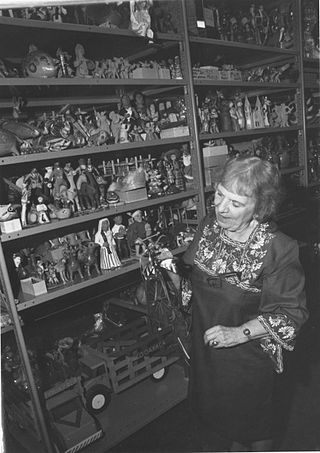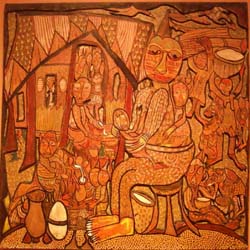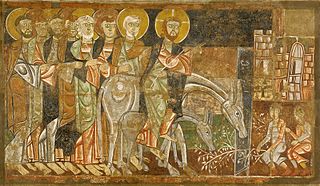
African art describes modern and historical paintings, sculptures, installations, and other visual cultures from native or indigenous Africans and the African continent. The definition may also include the art of the African diasporas, such as art in African-American, Caribbean or South American societies inspired by African traditions. Despite this diversity, there are unifying artistic themes present when considering the totality of the visual culture from the continent of Africa.

The Gẹlẹdẹ spectacle of the Yoruba is a public display by colorful masks which combines art and ritual dance to amuse, educate and inspire worship. Gelede celebrates “Mothers”, a group that includes female ancestors and deities as well as the elderly women of the community, and the power and spiritual capacity these women have in society. Focusing not only on fertility and motherhood but also on correct social behavior within the Yoruba society.

The Indianapolis Museum of Art (IMA) is an encyclopedic art museum located at Newfields, a 152-acre (62 ha) campus that also houses Lilly House, The Virginia B. Fairbanks Art & Nature Park: 100 Acres, the Gardens at Newfields, the Beer Garden, and more. It is located at the corner of North Michigan Road and West 38th Street, about three miles north of downtown Indianapolis, northwest of Crown Hill Cemetery. There are exhibitions, classes, tours, and events, many of which change seasonally. The entire campus and organization was previously referred to as the Indianapolis Museum of Art, but in 2017 the campus and organization were renamed "Newfields" as part of a branding campaign. The "Indianapolis Museum of Art" now specifically refers to the main art museum building that acts as the cornerstone of the campus, as well as the legal name of the organization doing business as Newfields.

Most African sculpture from regions south of the Sahara was historically made of wood and other organic materials that have not survived from earlier than a few centuries ago, while older pottery figures are found from a number of areas. Masks are important elements in the art of many peoples, along with human figures, often highly stylized. There is a vast variety of styles, often varying within the same context of origin depending on the use of the object, but wide regional trends are apparent; sculpture is most common among "groups of settled cultivators in the areas drained by the Niger and Congo rivers" in West Africa. Direct images of African deities are relatively infrequent, but masks in particular are or were often made for traditional African religious ceremonies; today many are made for tourists as "airport art". African masks were an influence on European Modernist art, which was inspired by their lack of concern for naturalistic depiction.

The Yoruba of West Africa are responsible for a distinct artistic tradition in Africa, a tradition that remains vital and influential today.

Mega-Gem is an outdoor sculpture by American artist John Francis Torreano. It is located on the Indiana University-Purdue University Indianapolis (IUPUI) campus, which is near downtown Indianapolis, Indiana, and is owned by the Indianapolis Museum of Art. The oversized sculpture, made of aluminum, is shaped like a round-cut diamond resting on one its facets and studded with 36 smaller, colored-metal rosettes.
Portrait of History, a public sculpture by Chinese American artists Zhou Brothers, is located on the Indiana University-Purdue University Indianapolis campus, which is near downtown Indianapolis, Indiana. The sculpture is located at the Blackford Street entrance to the Herron School of Art and Design. This piece is one of four public artworks on loan from the Indianapolis Museum of Art to IUPUI. The artworks were moved to the campus on March 22, 2009. Portrait of History is a bronze sculpture measuring 100 x 24 x 30 in and is mounted on an oval cement base.

Nymph and Fawn is a public artwork by American artist Isidore Konti and located within the Oldfields–Lilly House & Gardens estate on the grounds of the Indianapolis Museum of Art (IMA), near Indianapolis, Indiana. Created in 1917, the bronze sculpture is also a working fountain. It portrays a female nude pouring water from an urn while standing beside a small fawn.

A tatanua is a type of traditional mask made by the natives in the province of New Ireland, Papua New Guinea. The masks are made of wood and other natural materials and used in funeral ceremonies called malagan.

The Caplan Collection of folk art and childhood artifacts is held by The Children's Museum of Indianapolis; in 1984 it was donated by Frank and Theresa Caplan, owners of the Creative Playthings toy company. The museum began accessioning the collection in January 1985. The collection consists of nearly 32,000 objects, from toys to dolls to games to musical instruments to masks to clothing to folk art from over 120 countries. The museum created a specific exhibit for the collection, entitled "Passport to the World," which opened in 1986. Initially the Caplans had intended for the collection to be the basis of a new Museum of Fantasy and Play, but this never materialized and they donated their collection to the Children's Museum instead. The Caplans spent about US$1 million acquiring the objects from around 1965 to 1985; some of the countries strongly represented are Japan, Mexico, Russia, Germany, Indonesia, and India.

An Epa mask is a ceremonial mask worn by the Yoruba people of Nigeria during the Epa masquerade. Carvings representing priests, hunters, farmers, kings, and mothers are usually depicted on the masks. They are used to acknowledge important roles within the community, and to honor those who perform the roles, as well as ancestors who performed those roles in the past.

An adorned wood face mask from the We (Wee) people of West Africa, dated to the 20th century is in the permanent African collection at the Indianapolis Museum of Art and on display in the Eiteljorg Suite of African and Oceanic Art.

Healing of Abiku Children is a piece created by the Nigerian artist Twins Seven Seven in 1973, located in the Indianapolis Museum of Art, which is in Indianapolis, Indiana, United States. It consists of a large wooden plaque intricately carved and dyed with pigment to depict an important Yoruba ceremony. In it, a mother consults with a priest to keep her abiku twins in this world, rather than dying and being reborn to her over and over.

Entry of Christ into Jerusalem is an 1125 fresco by the Master of San Baudelio de Berlanga, originally located at San Baudelio de Berlanga but now on display in the Indianapolis Museum of Art, which is in Indianapolis, Indiana. It depicts Christ and seven disciples entering Jerusalem to the acclaim of its inhabitants.

Agere ifa is a holding receptacle, vessel or container for keeping and raising the sacred palm nuts or ikin used in Yoruba divination. Most Agere are made from a medium of wood, but also ivory and coconut shells.

This large, mid-19th century Moroccan wall hanging, or haiti, is a highlight of the textile collection of the Indianapolis Museum of Art, which is in Indianapolis, Indiana. Made in the cultural center of Fez, it is crafted of the finest materials: silk velvet embroidered with gold metallic thread.

This high chest of drawers, also known as a highboy or tallboy, is part of the Decorative Arts collection of the Indianapolis Museum of Art in Indianapolis, Indiana. Made between 1760 and 1780 in Philadelphia, Pennsylvania, its design was inspired by British furniture-maker Thomas Chippendale.
This wooden female ancestor figure by an unknown Senufo artisan is part of the African collection of the Indianapolis Museum of Art, which is in Indianapolis, Indiana. Carved in the first half of the 20th century, it displays the artist's skill with form and respect for the powerful female half of the primordial couple.
Harrison Eiteljorg was an American philanthropist, businessman, and patron of the arts. The Eiteljorg Museum of American Indians and Western Art was named after him for his donation of visual arts by indigenous peoples of the Americas and Western American paintings and sculptures. Until his death in 1997, Eiteljorg served as chairman of the museum's board.
Holly Wilson is a Native American artist from Oklahoma. She is an enrolled member of the Delaware Nation and is of Cherokee descent.















